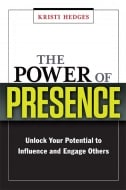3 Steps to Presence: Book Review of The Power of Presence
This blog is reader-supported. When you purchase something through an affiliate link on this site, I may earn some coffee money. Thanks! Learn more.
Read our review guidelines.

But if you don’t have it – or don’t feel that you do – how can you get people to act like that around you?
Unsurprisingly, it isn’t about other people at all. “Executive presence begins in your head,” writes Kristi Hedges in her book, The Power of Presence: Unlock your Potential to Influence and Engage Others. “It resides in how you think about yourself, your abilities, your environment, and your potential…most of what you need is right there in you, waiting to be tapped for your professional life.” In other words, if you have skills in other areas such as being great at karaoke or as a baseball coach, tap into those skills and transfer them to the workplace.
You can’t change how other people act, but you can change how you act, which in turn will improve your presence. Hedges sets out a three step model called I-Presence for building presence. The three steps are:
- Intentional
- Individual
- Inspirational
Intentional
Presence is underpinned by your personal values and what you want to be known for. It’s then impacted by the situation you are in and the feeling or attitude you want to convey in that situation. It is important to get the intention right and to match your mood with the appropriate situation and emotion.
Part of developing the right presence for the right situation is managing how you dress. “Anything connected to work counts as work,” she writes. “I’m talking about plane rides for business, retreats, even office happy hours or parties. The workplace rules still apply.”
Individual
People don’t connect with faceless leaders; they connect with individuals. Consequently, you need to be individual and relate to people as individuals. Hedges writes:
“In the workplace, strong connections make us more productive employees, better coworkers, and motivating leaders. Connections provide us with influence…Once upon a time, when you wanted to win someone over you’d do it informally; you’d walk down the hall for a friendly chat or catch up at happy hour. But when your colleagues are scattered across the country (or around the world), that becomes considerably harder to pull off.”
Hedges talks about smiling in the previous section of the book but I think it fits better here. In fact, while she splits the book into these three I sections, many of the points she makes could fit equally well under different headings. I like the advice about smiling:
“First, smiling is one of the simplest micro-actions that builds an approachable and trustful presence. Unless you are delivering bad news, smiling is good. Second, smiling lifts your spirits in general, and feeling positive can only help you in your quest to build a stronger presence.”
Hedges also writes about the importance of getting feedback: you can’t improve your presence unless you know what your current baseline is. This is hard to do: it’s not like asking your colleagues to audit your projects based on project management checklists. You are asking people to judge you, and you may find it hard to get honest answers.
Hedges suggests talking to trusted colleagues, a mentor or friends at work and this is a good starting point. However, those people may not see you in action in meetings or with your team so they may not have the full picture of your presence at work. Getting feedback in this situation is something I would have liked to know more about.
Inspirational
There’s a lot of fluff around inspiration but Hedges has an easy suggestion to build inspiration in your listeners based on the work of David Rock. It’s the SCARF model and it looks like this:
Status: ensure your message is not seen as a threat to the status of the listener. Status increases when people are publicly praised or recognised, so say thanks to your project team (make sure you mean it though).
Certainty: set expectations appropriately and let people know what is going on every step of the way.
Autonomy: don’t micro manage the project team. Give them as much scope for controlling their own work as possible.
Relatedness: people like feeling related to others and being with the ‘in’ crowd. Make your project meetings and social events inclusive.
Fairness: being unfair creates frustration and won’t win your listeners over. Make sure your project decisions are fair and the rationale behind them is explained.
The section on inspiration is, in my opinion, the best part of the book. Hedges writes about inspiring language. She suggests using phrases like ‘I will’ instead of ‘I might’ as the latter keeps you in the realm of giving people information, not inspiring them.
“Part of being inspiring is simply being interesting,” she writes. “Having an impassioned point of view or a bold take on a situation is far better than the alternative – being taciturn and forgettable. A leader who plays it safe and stays under the radar inspires no one.”
This is not a project management book. It’s a book aimed at everyone trying to make a better impression at work. The I-Presence model is a bit contrived but the advice is solid. Gift it to the people you mentor, but make sure they want to develop their personal presence first! Giving feedback is a delicate matter…
